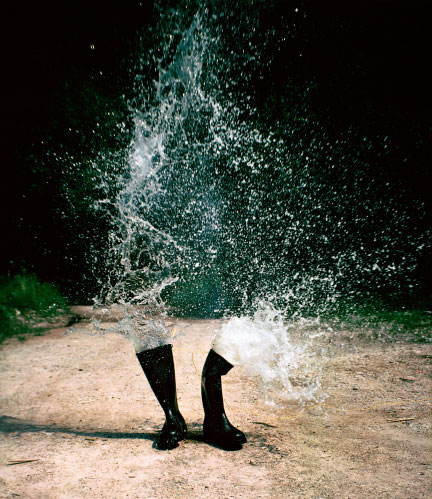Signer’s works have acquired the label ‘time-sculpture’. They share traditional sculpture’s concern with the crafting of physical materials in three dimensions, but they extend that concern into what may or may not be characterised as the fourth dimension: the dimension of time. Time-sculpture investigates the transformation of materials through time, focusing the viewer’s attention on the experience of the event, the changes wrought, and the forces involved. Variously combining three-dimensional objects, live action, still photography and moving-image documentation, Signer’s time-sculptures frame episodes of the containment and release of energy − always with ingenuity, often with captivating, epigrammatic swiftness and irresistible humour. In Cap with Rocket (Mütze mit Rakete 1983), for example, a length of string connects a firework and a knitted hat that Signer has pulled over his head. The firework is ignited; it shoots into the air and whisks the hat away, revealing the artist’s face. In Stool − Kurhaus Weissbad (Hocker − Kurhaus Weissbad 1992) a small explosion triggers the catapulting of a four-legged stool out of a window; the stool sails through the air and crashes to earth. In Kamor (Kamor 1986) a gunpowder explosion at the summit of a small mountain in the Swiss canton of Appenzell produces a burst of flame and a plume of smoke and momentarily lends the summit the appearance of a live volcano. In Attaché Case (Aktenkoffer 1989/2001) a concrete-filled briefcase is taken on a short ride in a fast machine − a helicopter, to be precise. At a height of about a hundred metres it is dropped. Like a meteorite, it plummets into a grassy field and gouges a deep crater in the turf.
Simple! And in some ways, the step from sculpture to time-sculpture is indeed beautifully simple: elementary, to borrow a word the artist himself has often associated with his work. In the face of the striking immediacy and poetic plasticity of Signer’s pieces, critical commentaries can sometimes seem frankly redundant − like a dull-witted, pedantic glossing of a perfectly-timed, beautifully-judged joke. The critic is dogged by the suspicion that (to co-opt a phrase from Simon Critchley) a time-sculpture ‘explained’ might be a time-sculpture misunderstood. From a seemingly restricted palette of processes and materials, Signer generates a poetics whose tones range from the melancholy to the thrilling, from the charming to the violent, from the grave to the frankly, irresistibly silly, and many points north, south, east and west of these affective co-ordinates.
© Rachel Withers 2007, Excerpt from: Withers, Rachel, 'Collector’s Choice. Roman Signer (engl.). Volume 07', Cologne: Dumont Literatur und Kunst Verlag, 2007

